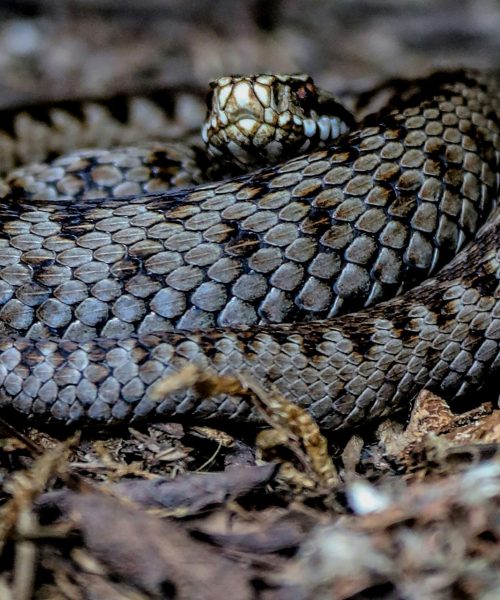Reptile Surveys Services for Planning & Development
Professional reptile surveys that support planning, protect your programme and minimise ecological risk.
Do you need a Reptile Survey?
You may need a reptile survey if your site contains features such as rough grassland, scrub, heath, woodland edges, brownfield areas or warm, open mosaics with good cover. PEAs frequently flag reptile potential early in the design process.
What is a Reptile Survey?
A reptile survey confirms presence/likely absence, maps activity levels and provides the evidence planners need to validate your application. It also defines any mitigation required to keep works lawful and efficient.

Early Signs a Reptile Survey is Needed
LPAs scrutinise sites with:
- rough grassland, scrub, heath or brownfield habitat
- rubble piles, banks, metal sheets, log stacks or warm microhabitats
- good sun exposure with nearby cover
- PEA flags for reptile potential
- local records of slow worm, common lizard, grass snake or adder
- earthworks planned between March and October
Early confirmation avoids validation queries, redesigns and seasonal friction.

What We Deliver
| Service | Purpose | Outcome |
|---|---|---|
| Initial Habitat & Risk Check | Early clarity before design commits. | Fast confirmation of risk and next steps. |
| Full Reptile Survey Programme | Presence/likely absence evidence. | Planning-ready report for validation and design. |
| Monitoring (Refugia / Transects / Camera) | Detailed activity data where risk is higher. | Clear mapping to guide planners and site teams. |
| Mitigation & Method Statements | Keep works lawful when reptiles are present. | Practical, build-friendly measures. |
| Licensing Support (if required) | Where habitat loss may affect reptiles. | Prepared applications aligned to project timelines. |
A practical, proportionate, planning-ready service.
How it Works

Scope & Schedule
Share your project location, habitat condition and intended programme. We confirm the correct survey level.

Fieldwork
Multi-visit surveys across suitable weather conditions using refugia, transects and targeted checks

Reporting
Planning-ready reporting, mitigation guidance (if needed), and clear actions for designers and site teams.
Timing & Survey Windows
Missing suitable weather conditions can delay evidence-gathering; early planning protects your programme.
Main Survey Season
March to October
Optimum
April–May, early autumn (weather-dependent)
Visits
Typically 2–7 under suitable temperatures (9–20°C), low wind, no heavy rain
What You Receive:
- site-specific habitat assessment
- presence/likely absence mapping
- risk summary for planners
- proportionate mitigation options
- licensing guidance (only if required)
- decisions and timelines your team can build around
Evidence planners rely on. Practical steps your project team can deliver.
Why Developers Choose ProHort:
- programme-first delivery
- practical, straight advice
- fast mobilisation where feasible
- reports shaped for planners, designers and contractors
- nationwide coverage
- development-focused ecological expertise
Legal Compliance & Planning risk
All common UK reptiles (slow worm, common lizard, grass snake, adder) are legally protected from killing, injury and harmful disturbance. LPAs require proportionate evidence where suitable habitat is present.
Missing or inadequate surveys can result in:
- planning refusal or validation delays
- design changes late in the programme
- stop-work requirements if reptiles are discovered during clearance
- more restrictive mitigation conditions
- project downtime caused by seasonal survey limits
Relevant legislation includes:
- Wildlife & Countryside Act 1981
- Conservation of Habitats and Species Regulations
- NPPF biodiversity and mitigation requirements
Our role is to keep everything compliant and predictable.
Your Next Step
Need an invertebrate survey? We’ll confirm your requirements and secure the right survey window.
Phone: 0800 494 7479
Email: [email protected]
Case Note
Reptile Survey FAQs
Do I need a reptile survey for planning?
You may need one if your site includes rough grassland, scrub, brownfield land, heathland, woodland edges or any habitat your PEA flags as suitable for reptiles.
When is the best time for reptile surveys?
Surveys run March–October, with peak activity April–May and early autumn. Weather must be suitable, so conditions influence scheduling.
How many survey visits are needed?
Most sites require 2–7 visits, depending on habitat size, risk level and planning expectations.
Can reptiles delay construction?
Yes. Disturbing reptiles is an offence. Early surveys prevent clearance delays, method-statement changes or redesign later in your programme.
What happens if reptiles are found?
We implement proportionate mitigation such as phased clearance, habitat manipulation or identifying receptor areas. Licensing is only required in higher-risk scenarios.
Do brownfield sites always need reptile surveys
Not always. It depends on habitat features and PEA findings. We can confirm quickly using your postcode and timeline.
Does missing the survey season delay planning?
It can. If presence/absence surveys cannot be completed, planners may defer decisions or impose conditions. Early screening avoids seasonal bottlenecks.
Will reptile surveys affect BNG?
Yes. Reptile activity can influence habitat values and enhancement requirements. We align BNG and reptile considerations early.
Can you support urgent timelines?
Yes. We regularly assist live programmes and can mobilise quickly where feasible.
What information do you need to quote?
A postcode or red line plan, habitat notes if available, expected work dates and any planner/PEA recommendations.



